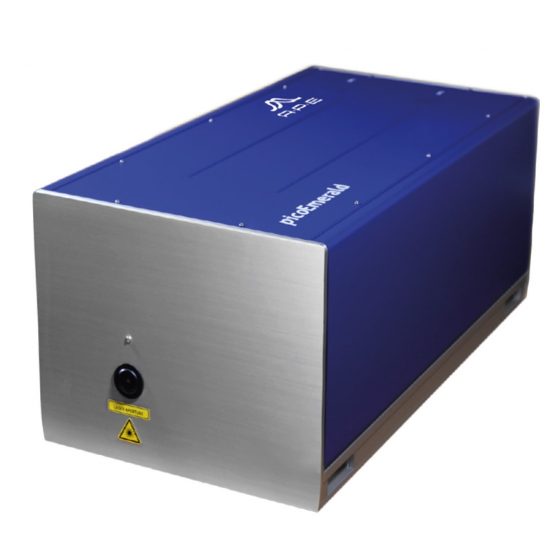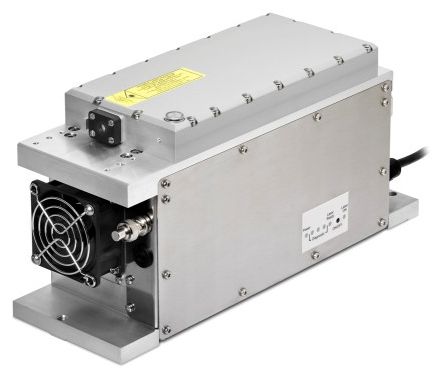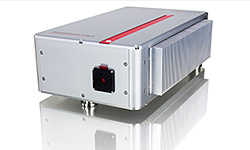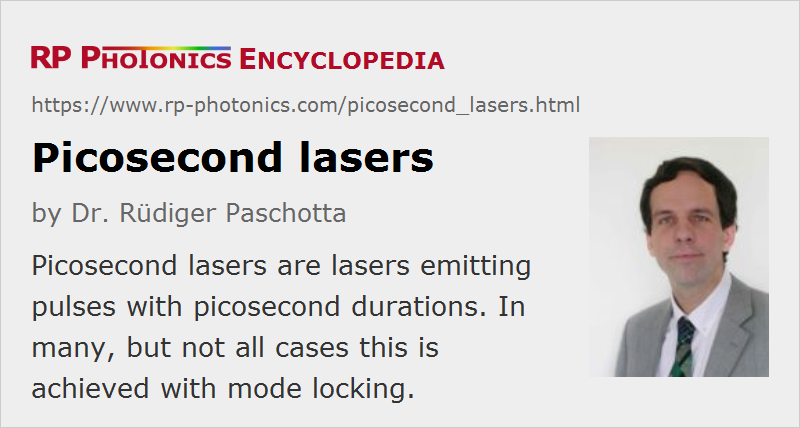Picosecond Lasers
Definition: lasers emitting pulses with picosecond durations
Alternative term: ultrafast lasers
More general terms: pulsed lasers, mode-locked lasers
German: Pikosekundenlaser
Categories: lasers, light pulses
How to cite the article; suggest additional literature
Author: Dr. Rüdiger Paschotta
A picosecond laser is a laser which emits optical pulses with a duration between 1 ps and (usually) some tens of picoseconds. It thus also belongs to the category of ultrafast lasers or ultrashort pulse lasers.
Sometimes, other laser-based sources for picosecond pulses – for example synchronously pumped OPOs – are also called picosecond lasers, even if they are strictly speaking no lasers.
A variety of laser types can generate picosecond pulses, with other performance parameters varying in wide ranges:
- The most common sources are actively or passively mode-locked solid-state bulk lasers. These can provide very clean (transform-limited and low-noise) ultrashort pulses with pulse repetition rates varying from a few megahertz to more than 100 GHz. For example, a passively mode-locked Nd:YAG or vanadate laser can easily generate e.g. 10-ps pulses with several watts of output power, and thin-disk lasers can generate many tens of watts in shorter pulses.
- Mode-locked fiber lasers can also cover a wide range of repetition rates from a few megahertz up to more than 100 GHz (with harmonic mode locking). Particularly with MOPA or MOFA systems, very high average output powers are possible. The pulse quality from such sources varies; for example, the pulses may or may not be close to bandwidth-limited.
- Lower repetition rates are possible with an additional pulse picker and also allow for amplification to higher pulse energies e.g. with a regenerative amplifier, possibly using chirped-pulse amplification. Cavity dumping of a mode-locked laser is another option.
- Laser diodes can be mode-locked for picosecond pulse generation (→ mode-locked diode lasers). This leads to compact sources with typical pulse repetition rates between 1 GHz and hundreds of gigahertz. However, the pulse energy is severely limited, and the pulse quality is not always high.
- Laser diodes can also be gain-switched with carefully designed electronics to achieve pulse durations of well below 1 ns, sometimes even below 100 ps. This leads to very compact and potentially cheap sources, and another advantage is that the pulse repetition rate can easily be varied in a very wide range simply via the driver electronics.
- Although Q-switched lasers typically generate nanosecond pulses, Q-switched microchip lasers can reach pulse durations far below 100 ps.
- More exotic sources of picosecond pulses are free electron lasers, which can provide high pulse energies even in extreme wavelength regions.
Compared with femtosecond lasers, picosecond laser sources are often more economical. In applications such as micromachining, they offer similar performance.
Suppliers
The RP Photonics Buyer's Guide contains 73 suppliers for picosecond lasers. Among them:


APE
The picosecond laser source picoEmerald emits ultra-short pulses with a duration of 2 picoseconds (other durations possible). The wavelength tuning of the ps laser is fully automated across a tuning range of 700 to 990 nm (signal) and 1080 to 1950 nm (idler). The fundamental beam at 1032 nm is also available. A wavelength scan / sweep function for fast spectra acquisition over certain specific wavelengths is included.
The key-facts of the picoEmerald are:
- wavelength 1 IR beam 1032 nm
- wavelength 2 tunable 700 … 990 nm
- wavelength 3 tunable 1080 … 1950 nm
- 80 MHz pulse repetition rate
- temporal and spatial overlap of the output wavelengths
- integrated time-delay between the wavelengths
- common output port for all beams
- fully automated wavelength tuning
- EOM optionally integrated


Teem Photonics
Teem Photonics offers a wide range of lasers with pulse durations as short as 100 ps. For example, the 266 nm PNU-M01210-1x0 laser, belongs to the Powerchip laser series, which also covers wavelengths of 1064 nm, 532 nm, 355 nm and 213 nm with pulse durations below 500 ps. Peak powers of tens of kilowatts (or even 160 kW at 1064 nm) are generated. Compared with mode-locked picosecond lasers, the pulse repetition rates are limited to about 100 kHz), while the pulse energies are far higher – tens of microjoules.


TOPTICA Photonics
TOPTICA is renowned for providing most stable picosecond and sub-picosecond oscillators/seeders for high-power material processing systems. Owing to our industry-proven robust and compact design, we have set new standards for laser-based material processing systems.


IPG Photonics
IPG Photonics offers a broad range of industrial grade picosecond and femtosecond pulsed fiber lasers. In comparison to nanosecond lasers, ultrafast is a "cold" process that reduces melt and HAZ, so there is less recast material. Femto and picosecond lasers also produce fewer micro-cracks and overall higher surface quality. These ultrafast lasers are ideal for a wide variety of industrial, medical and scientific applications.


RPMC Lasers
RPMC Lasers offers one of the widest wavelength selections of picosecond lasers available ranging from the UV through the IR. Our offerings include DPSS lasers, fiber lasers, and microchip lasers with pulse energy as high as 100 mJ and pulse repetition rates up to the MHz range.


NKT Photonics
NKT Photonics has developed a wide range of different picosecond fiber lasers for scientific and industrial applications. The Katana platform offers from 20 ps to nanosecond pulse durations, continuously tuneable repetition rate that can be triggered internally or externally allowing for laser operation in both master and slave mode. Katana is streamlined to offer high-power picosecond pulses in green, yellow, orange, red and infrared.


EKSPLA
Due to their excellent stability and high output parameters, EKSPLA scientific picosecond lasers established their name as “Gold Standard” among scientific picosecond lasers. The innovative design of the new generation of picosecond mode-locked lasers features diode-pumping‑only technology, thus reducing maintenance costs and improving output parameters. Second, third, fourth and fifth (on some versions) harmonic options combined with various accessories, advanced electronics (for streak camera synchronization, phase-locked loop, synchronization of fs laser) and customization possibilities make these lasers well suited for many scientific applications, including optical parametric generator pumping, time-resolved spectroscopy, nonlinear spectroscopy, remote sensing, metrology and others.
Questions and Comments from Users
Here you can submit questions and comments. As far as they get accepted by the author, they will appear above this paragraph together with the author’s answer. The author will decide on acceptance based on certain criteria. Essentially, the issue must be of sufficiently broad interest.
Please do not enter personal data here; we would otherwise delete it soon. (See also our privacy declaration.) If you wish to receive personal feedback or consultancy from the author, please contact him e.g. via e-mail.
By submitting the information, you give your consent to the potential publication of your inputs on our website according to our rules. (If you later retract your consent, we will delete those inputs.) As your inputs are first reviewed by the author, they may be published with some delay.
See also: mode-locked lasers, mode locking, ultrafast lasers, femtosecond lasers, ultrashort pulses, nanosecond lasers, solid-state lasers, mode-locked fiber lasers
and other articles in the categories lasers, light pulses
 |






If you like this page, please share the link with your friends and colleagues, e.g. via social media:
These sharing buttons are implemented in a privacy-friendly way!